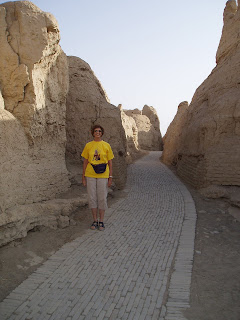 During the last month we have had a couple of fun outings. One was to the Confuscious Temple here in Nanjing. The other was to Yangzhou, a city about an hour and a half from here.
During the last month we have had a couple of fun outings. One was to the Confuscious Temple here in Nanjing. The other was to Yangzhou, a city about an hour and a half from here. Main Confuscian Temple
The Confuscian Temple is actually several buildings in a large area that is filled with small shops selling souvenirs, restaurants galore, and more people than you'd want to see in a month. It is built along a small tributary river that flows into the Yangzi river here at Nanjing.
Turn arround from the above picture and you will find yourself looking across the river to an ornately decorated wall.
Included in the complex is the Imperial Examination History Museum where scholars once spent months--or years--in tiny (no larger than 4 feet by 4 feet) cells studying Confuscian classics in preparation for civil service examinations. We have seen replicas of the scrolls--very long and amazing works of calligraphy!
Jim with a statue of one of the famous scholars who passed the civil service tests. When someone passed the rigorous tests he was set for life. Working for the government guaranteed success and an important place for your family in the future
Here I am crossing the river along a lantern-decorated bridge. This is the couple who took us to the Confuscian Temple area. We met her because we volunteer at the kindergarten (actually a huge, 300-student nursery school) where she teaches. We go one afternoon a week for an hour and teach the little children songs in English. It is fun and the kids are cute!

They took us to lunch. There are probably 8 kinds of soup, as well as assorted other Chinese dishes. We always leave the table absolutely stuffed when we dine with Chinese people. It is considered impolite to finish everything. Then the host will think he has not fed you enough! Note the chposticks. We are becoming quite handy wtih them. I can now lift individual grains of rice!

Last Sat. we went to Yangzhou. It was once a center of the salt trade in this part of China. One of the salt merchants build a lovely garden and home complex which we visited when we were there. This is in the entry area. Note the lovely flowers. There are many areas of flowers like this in China. The amazing thing is that they are all in pots, never planted directly into the ground. Many of the walkways in the complex were beautiful lmosaics like the one Jim is pointing to.
This complex had several "houses" connected by outdoor walkways and balconies. Here I am on one of the balconies which overlooks a stage where the owner had operas, music and other theatrical activities performed. The water and location make the acoustics amazingly clear for being outside.
Yangzhou is noted for its fried rice and dumplings. For lunch we had both, along with many other Chinese dishes. Once again we ate and ate and ate. You'd think we were getting fat here, but we're not. Jim is drinking soup from a dumpling, the first time we have had that. The soup was quite tasty and we just poked the straw into the dunpling and sucked out the broth.
After lunch we visited Slender West Lake Park. It used to be a moat around the city, but is now just a lovely lake with many bridges. I am standing so you can see Bridge 24, one of the more famous ones.
This is the five pagoda bridge, a rather ornate bridge that has lovely paintings of cranes on the ceilings of the pagodas. The weather was rather cool, cloudy and damp so the pictures are not as good as we take on sunny days.

































